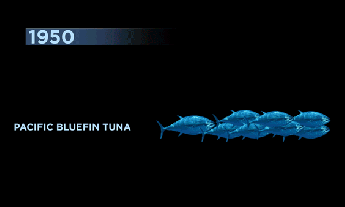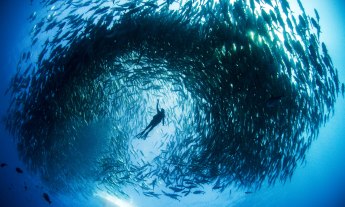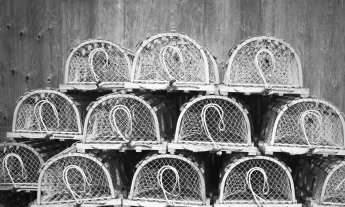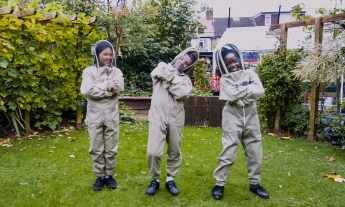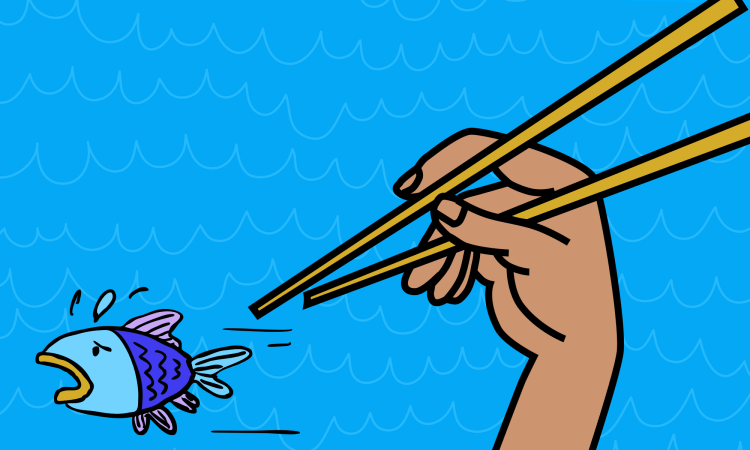
We asked legendary oceanographer Sylvia Earle for her menu advice.
Oceanographer (and TED Prize winner) Sylvia Earle (TED Talk: My wish: Protect our oceans) has spent half a century campaigning to save the world’s seas. A new Netflix original documentary about her life’s work sheds light on the environmental impact of the commercial fishing industry and Earle’s crusade to create underwater “hope spots” through her organization, Mission Blue. After watching the film, it’s hard not to wonder: Are any fish still okay to eat? We turned to our favorite aquanaut for advice. Below, check out Earle’s take on wild fish, tuna rolls, and her ideal meal.
To restore the ocean ecosystem, you’re saying we must put an end to overfishing and bottom trawling, which you liken to “catching songbirds with a bulldozer.” Is there such a thing as eating fish responsibly these days?
Except for those living in coastal communities — or even inland if we’re talking freshwater species — for most people, eating fish is a choice, not a necessity. Some people believe that the sole purpose of fish is for us to eat them. They are seen as commodities. Yet wild fish, like wild birds, have a place in the natural ecosystem which outweighs their value as food. They’re part of the systems that make the planet function in our favor, and we should be protecting them because of their importance to the ocean. They are carbon-based units, conduits for nutrients, and critical elements in ocean food webs. If people really understood the methods being used to capture wild fish, they might think about choosing whether to eat them at all, because the methods are so destructive and wasteful. It isn’t just a matter of caring about the fish or the corals, but also about all the things that are destroyed in the process of capturing ocean wildlife. We have seen such a sharp decline in the fish that we consume in my lifetime that I personally choose not to eat any. In the end, it’s a choice.
What if I just want to have a tuna roll every once in a while, as a treat? Would that be so bad?
Ask yourself this: is it more important to you to consume fish, or to think of them as being here for a larger purpose? Today, marine fish are being caught with methods that our predecessors could not even imagine. Our use of large-scale extraction of wildlife from the sea is profoundly detrimental to the environment. We’re using modern techniques capable of taking far more than our natural systems can replenish. Think about it — the factory ships that use enormous nets or log lines, some of which are 50- to 60-miles long, with baited hooks every few feet, they take more than can be replenished naturally, and they take indiscriminately. Worst of all are the bottom trawls that scoop up the whole ecosystem. And most of what’s taken in them is simply discarded. With respect to the ocean systems, they’re just leaving a hole. A huge space that is not going to be filled overnight. It’s not eco-conscious to eat tuna — maybe thousands of plants make a single pound of Blue Fin Tuna. It’s also difficult to replenish that species of fish, as they take years to mature. Not to mention that you’re consuming all of the toxins that the fish has consumed over the years.
Sometimes it gets confusing. We’re told not to eat so many things already — like not to consume cows, pigs or chickens from factory farms for both health and moral reasons. Now you’re saying we shouldn’t eat fish either. Does that mean we should all follow a plant-based diet, for both health and moral reasons?
It’s obvious. It’s not a matter of me saying so. It’s not a matter of opinion. There’s no question that a plant-based diet is better for you and better for the planet. If you ask me, the best thing is a plant-based diet — or a largely plant-based diet, with small amounts of meat coming from plant-eating animals. I’m not saying that you have to stop eating meat, but think about what it takes to make a plant compared to what it takes to make a plant-eater, like a cow, chicken or pig. Even carnivores on land are lower on the food chain than most fish. Think of a tiger or lion or a snow leopard. They eat plant-eating animals. They eat rabbits or deer. So, food chains on land tend to be fairly short. Over 10,000 years, we have come to understand that it’s far more efficient not to eat carnivores. We eat grazers, the ones that we choose to raise, such as cows and pigs. Perversely, many of the animals that are natural grazers, we are force feeding wild fish. We’re taking large quantities of ocean wildlife, grinding them up, and turning them into chicken food or cow food or pig food — or even into fish food.
If you have to eat meat, or rather choose to eat meat, eat animals that eat plants.
So if you have to eat meat, or rather choose to eat meat, eat animals that eat plants. In the case of fish, there are long and twisted food chains — for example, the tuna that eats fish that eats fish that eats fish. We choose to go high up the food chain when we eat halibut or swordfish or tuna or lobster, but ultimately that’s not what’s good for us or for the ocean.
You’ve mentioned that a sea bass can live up to 80 years and that we’re often unaware of how old the fish is that we’re consuming. Why is that important to consider?
We need to consider the bioaccumulation of what’s in the ocean. Mercury concerns exist with good reason, especially when eating carnivorous fish like tuna, swordfish, halibut, and orange roughy. It’s not the smartest thing for our personal health because of what accumulates in these top carnivores over the years. If you want to eat responsibly, not just for your health but again for the health of the planet, know that the longer an animal is exposed to the world as it is today, the greater the chance of accumulating the toxins that now exist within the ocean or within freshwater, or even on land. What farmers choose to grow for consumption — for economic and taste reasons — tend to be young animals, like chickens, barely a year old, not 10-year-old hens. In fact, hens don’t usually get to be that old. We eat cows young — yearlings, sometimes two-years-old, but not 10 or 20 years old. We eat far more animals that are a few months old, not years in the making. But in the ocean, it takes 10-14 years for a Blue Fin tuna to mature, let alone to reach its full potential. So let’s say you take a young tuna, 10-years-old — think of how many fish have been consumed in a 10-year period to make even a pound of one of those wild ocean carnivores.
What about local fishers who depend on fishing as a means of survival?
I do have sympathy for those who have a long tradition of making their living by extracting wildlife. I don’t think they should be targeted as the problem. But even they know that, armed with modern technologies, they have the power to extract far beyond what natural systems can produce. We need common-sense steps to protect feeding and breeding areas in coastal areas. We need to have a system with restrictions, not just be able to take stuff from all places at all times in unrestricted numbers. We have a chance now, because we now know what we could not understand a few decades ago. Smart agriculture may be an option for providing food for people who like to have aquatic creatures. But it has to be done with extreme care and with protection. We need a safe haven for these wild creatures, to recover from what we have already taken, as well as sustain what we might take in the future.
What about catch shares and privatized fish farming?
Those are well-intentioned, but not approaches that I necessarily endorse. I think that the best value for aquaculture comes in closed systems where you recycle water, capture nutrients, and do not let the nutrients that are produced by the fish escape, which is what happens in these open-sea farms. In fact, it can be a problem when you concentrate fish and don’t allow them to move around. Or even when they have these open pens, which they are proposing to float widely in the ocean. These are approaches that are aimed at service choices, not needs. These approaches continue to focus on the luxury taste we have acquired, not the need that people have for food. For food, the best value you get is in raising plant-eating fish under circumstances where, as they say, you get “more crop per drop”; where you capture the nutrients and recycle them into plant-based farms. In nature, there is no waste. Part of the problem in taking so many fish out of the ocean is that you’re breaking the lakes and the crucial chain that gives back with its constant movement of nutrients. A smart aquaculture system is not one that is in the ocean or even in a natural body of water, but one that is designed like an aquarium, functioning like a big figure eight: plants on one side, fish on the other. The plants go to the fish and the nutrients go to feed a vegetable garden, with sunlight driving it all. The fish farms that raise carnivores need to be looked at with the understanding that taking large quantities of wildlife, wild fish, to get small quantities of farm fish, is not a sensible way to run a planet.
OK. You’ve convinced me. No more fish. When did you decide to give it up?
It was a gradual process. I come from an omnivorous dining family and eating seafood was just a natural thing to do. First in New Jersey, where the wildlife was captured and consumed locally, then in Florida. But even when I lived in Florida, it was clear that the numbers were going down as our numbers were going up. Now with 7 billion people on the planet, eating wildlife has to be a luxury, except for in those coastal communities that have few choices about what to consume. Today, armed with modern technologies, we can easily diminish and eliminate local wildlife. It isn’t like 10,000 years ago or 5,000 years ago or even 50 years ago. These days, our capacity to kill greatly exceeds the capacity of the natural systems to replenish. The amazing thing is that our focus is on looking at ocean wildlife primarily as food. In North America really, it is always a choice. It is never, as far as I can tell, a true necessity, given our access to other food sources. So I choose not to eat it.
What is your ideal meal? For example, if you could have anything for dinner tonight, what would it be? A sustainable meal of course.
There are so many choices. It’s not coming down to any one particular thing. I love the creative choices that are now available that didn’t exist when I was a child. Grains that are high in protein and have much more flavor than some of the more traditional ones like rice, and variations on the theme of legumes, eaten raw or cooked or incorporated into various recipes. People think of a plant-based diet as boring. But it’s only in your imagination, or lack of it, that plants are boring. There are 250,000 kinds of land-based plants — and then in the ocean, depending on how you count, if you include the plankton — you’re looking at maybe another 20,000 that we know about, including seaweed cultivated for the omega oils that people want. You don’t have to kill fish to acquire omega oils.
One last question. You’ve logged more than 7,000 hours underwater, researching and observing wildlife. Is it true that different fish have different personalities?
The wonderful thing about life as a biologist is that every individual — not just people or cats or dogs or horses — but all living things, even trees, are unique. Every being is unique. It’s just a fact. And certainly with fish, like birds, they all have a distinctive appearance and if you’re sharp enough to distinguish one from another you soon begin to see that they behave differently. If that’s personality, which I guess it is, each one has its own little quirks. For example, some fish are more aggressive, some are shy. And it’s wonderful spending thousands of hours under the ocean getting to know not just “the grand suite” or the kaleidoscope of life out there, but also to recognize all the individual pieces.
Featured image by Emily Pidgeon/TED.












